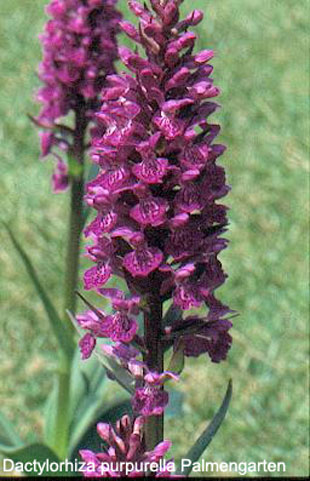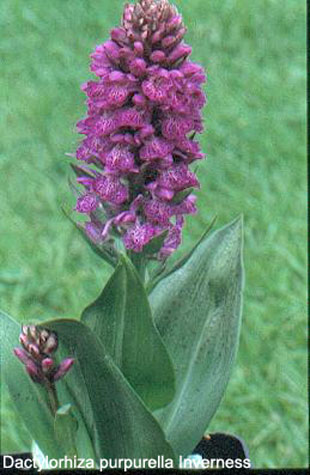| Remarks
to the offered plants:
Dactylorhiza
incarnata ssp. hyphaematodes: The leaves are redish on
both sides. This extrordinary form occurs usually together with
normal green plants. However, red leaved plants are more common
than normal green plants within a given population. Seeds from a
single capsule resulted in 76,5% red leaved and 23,5% green leaved
plants..

Dactylorhiza purpurella "Palmengarten".
This D. purpurella-hybrid
is medium tall and dark purpur. Forms groups after a few years.
All Dactylorhiza-hybrids are totally hardy and grow well in ordinary
garden soil.

Dactylorhiza
purpurella "Inverness". These plants are
compact and stay short. Group forming.Very similar to the natural
species. Easy in culture.
|
Distribution:
Dactylorhiza is a large genus of more than 50 species. Distributed
in the northern hemisphere from Europe to Alaska. Naturalised in
some areas in North America. Several centers of diversivication
e. g. the European Alps, Scandinavia and Baltics, temperate Anatolia
and Caucasus, and the British Isles.
Description:
Flower stems 10 to 100cm high, with cauline leaves. Dactylorhiza
has small to medium sized, numerous flowers. A spur is always present
on the labellum. The perianth segments spread or form a hood. All
species are insect pollinating. Tubers are digitate fingerlike and
transform into roots. There are also roots on top of the tubers.
The section around D. sambucina has more rounded, only shortly digitate
tubers.
Culture:
Most Dactylorhizas are very easy to culture. Generally prefering
sunny places or partial shade for woodland species. D. sambucina
and similar species prefer fresh soil conditions in spring and dryer
conditions in summer. The other species like to grow in freh to
wet soils throughout spring and summer. With exception of the mediterranean
species and D. foliosa from Madeira all species are very frost hardy.
Regular watering during the growing period is essential for pot
culture. Fertilize regularly with 0.2g/l in poor soils or pot culture
in spring and summer. Avoid soggy conditions during dormancy in
winter. Dactylorhizas generally should be grown outside, planted
in the garden, if possible.
Recommended potting mixes:
Substrates should be well draining with a good water
capacity and a pH of about 6 to 7. Most commercially available potting
mixes are suitable.
Further reading:
Orchids of Britain & Europe. Pierre Delforge, 1995. Collins
Photo Guide. ISBN 0 00 2200244.
Orchideen im Garten: Verwendung, Pflege und Vermehrung. Gerd
Kohls und Ulrich Kähler, 1993.Parey, ISBN 3 489 636244.
Orchideen für den Garten: Europäische und tropische Erdorchideen.
Alfons Bürger, 1992. Ulmer, ISBN 3 8001 64876.
Das Moor im eigenen Garten: Moorgärten anlegen,gestalten
und pflegen. Erich Maier, 2000. Parey, ISBN 3 8263 3301 2.
Hardy orchids. Phillip Cribb and Christopher Bailes, 1989.
Timber Pr. ISBN 0 88192 147 5.
Die Orchideen Mitteleuropas und der Alpen. Presser Helmut,
1995. ecomed, ISBN 3 609 65600 X.
|

